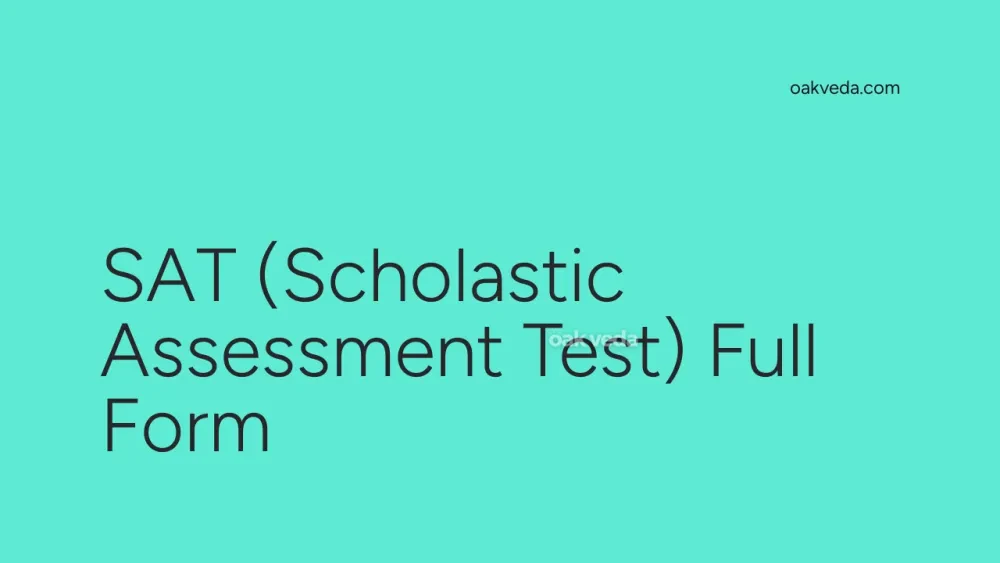
What is the Full Form of SAT?
The full form of SAT is Scholastic Assessment Test. This standardized examination plays a crucial role in the college admissions process for undergraduate programs, particularly in the United States and Canada. Administered by the College Board, the SAT is designed to assess a student's readiness for higher education by evaluating their verbal, mathematical, and written skills.
What is Scholastic Assessment Test?
The Scholastic Assessment Test, commonly known as the SAT, is a standardized test widely used for college admissions in the United States and several other countries. It is designed to assess a student's academic skills and their potential for success in higher education. The test evaluates critical thinking, problem-solving abilities, and knowledge in key subject areas that are essential for college-level work.
Origin and Development of Scholastic Assessment Test
The SAT has a rich history dating back to the early 20th century. Originally introduced in 1926 as the Scholastic Aptitude Test, it has undergone several changes and revisions over the years. The name was later changed to Scholastic Assessment Test to better reflect its purpose. In recent years, the College Board has made significant updates to the test format and content to align it more closely with high school curricula and college expectations.
How does Scholastic Assessment Test work?
The SAT is typically administered several times a year at designated testing centers. Students register for the exam and take it on a specified date. The test consists of multiple-choice questions and a written essay (which is now optional). Scores are calculated based on the number of correct answers, with no penalty for incorrect responses. These scores are then sent to colleges and universities as part of the student's application package.
Types of Scholastic Assessment Test
There are two main types of SAT exams:
-
SAT Reasoning Test (SAT I): This is the primary SAT exam that most students take. It assesses critical reading, mathematics, and writing skills.
-
SAT Subject Tests (SAT II): These are optional, subject-specific tests that some universities require or recommend. They evaluate knowledge in particular areas such as literature, history, mathematics, sciences, and languages.
Functions of Scholastic Assessment Test
The primary functions of the SAT include:
- Providing a standardized measure of academic abilities for college admissions
- Assessing a student's readiness for college-level work
- Offering colleges a common data point to compare applicants from diverse educational backgrounds
- Helping students gauge their academic strengths and weaknesses
Applications of Scholastic Assessment Test
The SAT is primarily used for:
- College admissions decisions
- Scholarship considerations
- Academic placement in college courses
- Identifying areas where students may need additional support or preparation
Features of Scholastic Assessment Test
Key features of the SAT include:
- Multiple-choice questions in reading, writing and language, and mathematics
- An optional essay section
- A scoring system ranging from 400 to 1600 points
- No penalty for incorrect answers
- Questions designed to reflect real-world scenarios and problems
Benefits of Scholastic Assessment Test
The SAT offers several benefits:
- Provides a standardized measure of academic abilities
- Helps students stand out in college applications
- Offers practice for critical thinking and problem-solving skills
- Can lead to scholarship opportunities
- Allows students to showcase their strengths in specific subject areas
Limitations or Challenges of Scholastic Assessment Test
Despite its widespread use, the SAT faces some criticisms and challenges:
- Concerns about test anxiety and its impact on performance
- Debates about the test's ability to predict college success accurately
- Issues of accessibility and fairness for students from diverse backgrounds
- The potential for the test to reinforce socioeconomic disparities
Future Developments in Scholastic Assessment Test Technology
The College Board continually works to improve the SAT. Future developments may include:
- Increased use of digital testing platforms
- More personalized testing experiences
- Enhanced alignment with high school curricula and college expectations
- Improved accessibility features for students with disabilities
FAQs on SAT Full Form
-
What is the eligibility criteria for taking the SAT? There are no strict eligibility criteria set by the College Board. However, most test-takers are high school students aged 17-19 preparing for college admissions.
-
How many times can I take the SAT? There is no limit to the number of times you can take the SAT. It is typically offered several times a year.
-
What is the structure of the SAT exam? The SAT consists of three main sections: Reading, Writing and Language, and Mathematics. There is also an optional Essay section.
-
How long does the SAT exam take? The SAT takes about 3 hours to complete, or 3 hours and 50 minutes with the optional Essay section.
-
How is the SAT scored? The SAT is scored on a scale of 400-1600 points. The Reading and Writing sections are combined for a score of 200-800, and the Math section is scored 200-800.
In conclusion, the SAT, or Scholastic Assessment Test, remains a significant component of the college admissions process. While it has faced challenges and criticisms, it continues to evolve to meet the changing needs of students and educational institutions. Understanding the full form and purpose of the SAT can help students better prepare for this important step in their academic journey.
You may be interested in:

